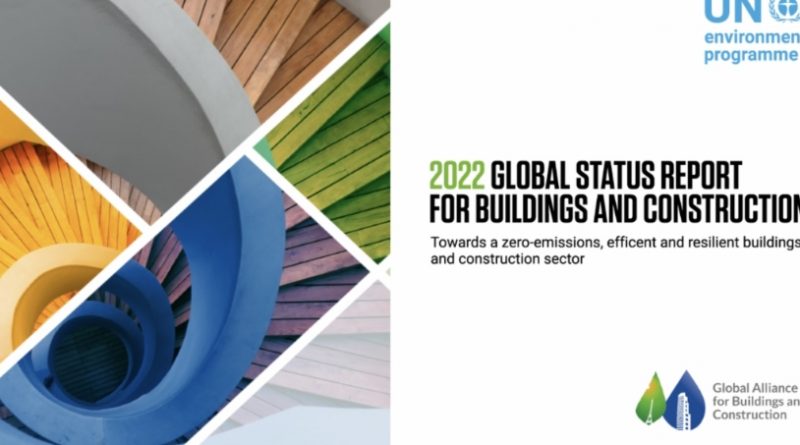CO2 Emissions from Buildings and Construction Hit New High, Leaving Sector Off Track to Decarbonize by 2050
Oru Leonard
In 2021, investments in building energy efficiency increased by 16% to
USD 237 billion, but growth in floor space outpaced efficiency efforts
The sector’s 2021 operational energy-related CO2 emissions were up 5 per cent over 2020 and 2 per cent over the pre-pandemic peak in 2019
Despite an increase in energy efficiency investment and lower energy intensity, the building and construction sector’s energy consumption and CO2 emissions have rebounded from the COVID-19 pandemic to an all-time high, a new report finds.
Released at the latest round of climate talks in Egypt, COP27, the 2022 Global Status Report for Buildings and Construction finds that the sector accounted for over 34 per cent of energy demand and around 37 per cent of energy and process-related CO2 emissions in 2021.
The sector’s operational energy-related CO2 emissions reached ten gigatonnes of CO2 equivalent – five per cent over 2020 levels and two per cent over the pre-pandemic peak in 2019. In 2021, operational energy demand for heating, cooling, lighting and equipment in buildings increased by around four per cent from 2020 and three per cent from 2019.
This, according to the report from the Global Alliance for Buildings and Construction (GlobalABC), means that the gap between the climate performance of the sector and the 2050 decarbonization pathway is widening.
“Years of warnings about the impacts of climate change have become a reality,” said Inger Andersen, Executive Director of the United Nations Environment Programme (UNEP). “If we do not rapidly cut emissions in line with the Paris Agreement, we will be in deeper trouble.”
The report shows that the sector can still change. For example, rising fossil fuel costs due to the war in Ukraine and the cost-of-living crisis are providing incentives to invest in energy efficiency – although the erosion of purchasing power and the impact of labour and materials may slow investment. “The solution may lie in governments directing relief towards low and zero-carbon building investment activities through financial and non-financial incentives,” continued Andersen.
The buildings sector represents 40 per cent of Europe’s energy demand, 80 per cent of it from fossil fuels. This makes the sector an area for immediate action, investment, and policies to promote short and long-term energy security”
Decarbonizing the buildings sector by 2050 is critical to delivering these cuts. To reduce overall emissions, the sector must improve building energy performance, decrease building materials’ carbon footprint, multiply policy commitments alongside action and increase investment in energy efficiency.
Key global trends
The sector’s emissions intensity in kilogrammes of CO2 per square metre dropped from 43 in 2015 to 40 in 2021.
Energy intensity in kilowatts per hour per square metre slightly decreased, from 153 in 2015 to 152 in 2021.
Investments in building energy efficiency have gone up by unprecedented levels, rising by 16 per cent in 2021 over 2020 levels to USD 237 billion.
However, growth is outpacing efforts on energy efficiency and reducing energy intensity.
The increase in global gross floor area between 2015 and 2021 is the equivalent to the total land area covered in buildings in Germany, France, Italy and Netherlands; if it were built on one level, at around 24,000 sq. km.
The report says that investments in energy efficiency must be sustained in the face of growing crises – such as the war in Ukraine and the ensuing energy crisis, and the cost-of-living crisis – to reduce energy demand, avoiding CO2 emissions and dampen energy cost volatility. The buildings sector represents 40 per cent of Europe’s energy demand, 80 per cent of it from fossil fuels. This makes the sector an area for immediate action, investment and policies to promote short and long-term energy security.
The report shows that the sector can still change. For example, rising fossil fuel costs due to the war in Ukraine and the cost-of-living crisis are providing incentives to invest in energy efficiency – although the erosion of purchasing power and the impact of labour and materials may slow investment. “The solution may lie in governments directing relief towards low and zero-carbon building investment activities through financial and non-financial incentives,” continued Andersen.
Also critical to reducing the sector’s emissions are including buildings in climate pledges under the Paris Agreement – known as Nationally Determined Contributions (NDCs) – and mandatory building energy codes.
The number of NDCs that mention buildings grew from 88 in 2015 to 158 in 2021. However, progress on buildings and construction policies and action remains slow. Over the same period, the number of countries with building energy codes rose from 62 to 79. However, only 26 per cent of countries have mandatory building energy codes for the entire sector.
A focus on Africa and building materials
The report has special focus sections on building materials, and the region of Africa.
Raw resource use is predicted to double by 2060 – with steel, concrete and cement already major contributors to greenhouse gas emissions. Materials used in the construction of buildings already account for around nine per cent of overall energy-related CO2 emissions.
Embodied carbon in buildings – the emissions associated with materials and construction processes – needs to be tackled to avoid undermining energy-saving measures. However, the sector can reduce its impact by, for example, looking at alternative materials and decarbonizing conventional materials such as cement.
The use of alternative materials is particularly relevant for Africa.
The African population is expected to reach 2.4 billion people in 2050 and 80 per cent of this growth will occur in cities. An estimated 70 per cent of the African building stock expected for 2040 has yet to be built.
To avoid increasing emissions while building the stock necessary to move people out of informal settlements, and to create buildings that are resilient to the impacts of climate change, the African sector should look at sustainable construction materials and design techniques, in which the continent is rich.
Africa is also rich in renewable energy sources, solar and wind, which nations can use to power their buildings sustainably.
Key recommendations
Build coalitions of national stakeholders to set targets and strategies towards a sustainable, zero-carbon and resilient buildings and construction sector through Buildings Roadmaps. Following the GlobalABC roadmaps process and model, more than 30 countries and territories have been developing roadmaps.
National and sub-national governments must establish mandatory building energy codes and set a pathway for their building codes and standards to achieve net zero as soon as possible.
Governments and non-state actors must increase their investment in energy efficiency.
The construction and real estate industries must implement zero-carbon strategies for new and existing buildings.
The building materials and construction industries must commit to reducing their CO2 emissions throughout their value chain.
Governments, especially cities, need to implement policies that promote the shift to ‘circular material economies’.
Fast-growing countries and economies need investment in capacity-building and supply chains that promote energy-efficient designs, low-carbon and sustainable construction
The UN Environment Programme (UNEP)
UNEP is the leading global voice on the environment. It provides leadership and encourages partnership in caring for the environment by inspiring, informing and enabling nations and peoples to improve their quality of life without compromising that of future generations.
The GlobalABC
Founded at COP21, hosted by UNEP and with 256 members, including 37 countries, the GlobalABC is the leading global platform for governments, private sector, civil society, research, and intergovernmental organizations committed to a common vision: A zero-emission, efficient and resilient buildings and construction sector.
(UNEP Media)




